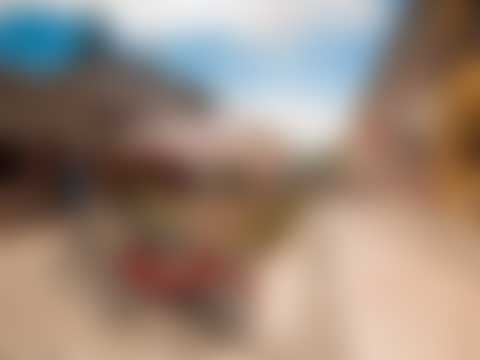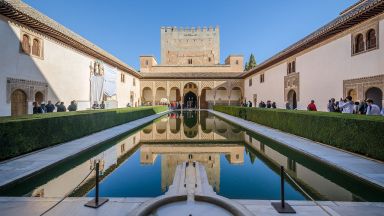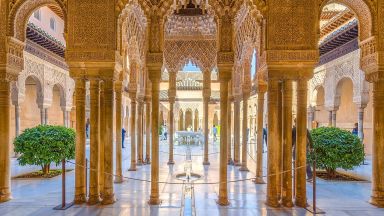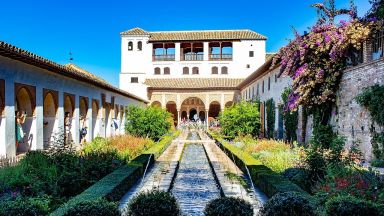Corral del Carbón
Courtyard and Market in Granada
The Corral del Carbón or The Coal House is a 14th-century market located in the Spanish city of Granada in Andalusia. It was originally Granada’s grain market, which would have been called an Alhóndiga. This old grain market lies in the center of the El Albaicín district. Nowadays, a number of cultural institutions, a tourist information center and small crafts shops are situated in this building and the hosts an occasional open-air performance in the courtyard. The building consists of an entrance pavilion and a courtyard surrounded by galleries and traditional workshops.
Short History of Corral del Carbón
The building dates back to 1336 in the period of the Moorish conquest of Yusuf I. It was located south of the Muslim city, next to the silk market or Alcaicería, and served as inn for merchants in transit, possible to the nearby Alcaiceria, or as a warehouse and wholesale market. After the Catholics reconquered Granada, they granted the building to Sancho de Arana. When he died in 1531 it was auctioned off and became a marketplace for carbón or coal, where it gets its current name. In 1593 it became a corral de comedias, or theatrical courtyard and as a community center. The rooms of the lower floor still being used to store coal.
It was declared a National Historic-Artistic Monument in 1918, but was threatened with demolition until it was acquired by the state in 1933 and restored by Leopoldo Torres Balbás.
Tours in and around the Corral del Carbón
There are only a few guided tours that include a visit to the Corral del Carbón and the area around it. We have listed them here.
What does the Corral del Carbón look like?
You’ll enter via a beautiful double-arched gate, which leads to a central courtyard around which are the lodgings that today serve as the offices for the city’s orchestra.
The large double-arched gate, has a horseshoe arch of scalloped brick, with arabesque spandrels carved from plaster. Over the door is inscribed words from the Quran ‘God is one, God is Eternal, He neither begets nor is born, nor to Him is there any equivalent’ . It also has two double windows, one on the first floor and another on the upper floor, topped with beautiful eaves with a large overhang, supported by corbels angled upwards.
Behind the facade, the hallway, which takes up two floors, has a beautiful ceiling and two blind arches on each side, with seats. The interior of the corn exchange is centered around a large, almost square patio with a pillar, was divided between three floors. The lower floor was for goods and pack animals, and the two upper floor, each with 22 small rooms, with lamps but without beds, with only large mats, were the rooms in which the merchants slept, wrapped in large cloaks.
Through two different pipes in the central pillar of the patio, water flowed from the Darro river, arriving from the Romayla canal, and from the Genil river, arriving from an urban branch of the Gorda canal. The floors are supported by stone pillars on the ground floor, and brick on the upper floors, with wooden footings very similar to those that the Maristán had.
There were no windows in the whole building, to prevent the goods being stolen, and for which the corn exchange master or fundeqayr would have been responsible, who lived in the rooms over the door, monitoring the arrival and departure of goods, Its only door was closed at sunset, the merchants not being able to leave until dawn. Just before sunset, they were told to gather their property and animals, opening the doors afterwards, thereby preventing anyone from taking what was not theirs.
The names of the Corral del Carbón
In the first half of the 14th century the Corral del Carbón, was called al-fundaq al-yadida in Arabic, which meant New Corn Exchange. After 1492 its function changed to being a marketplace for carbón or coal and its name was changed to reflect this.
Where is the Corral del Carbón located?
The Corral del Carbón is located just east of Calle Reyes Católicos. You can reach the Corral del Carbón taking routes 4, 8, 11, 21, 33 (the bus stop is ‘Gran Via 1’ or Cathedral), routes C31, C32, C34 (the bus stop is ‘Plaza Isabel Catolica’).
The Corral del Carbón appears in our Complete Guide to Visiting Granada!
This website uses affiliate links which may earn a commission at no additional cost to you!
Visiting Corral del Carbón
Monday – Friday 9:00 – 19:00
Saturday and Sunday 10:00 – 14:00
Free
Nearby Attractions
- Alcaicería (0.1) km
Market in Granada - Realejo (0.1) km
Area in Granada - Royal Chapel of Granada (0.2) km
Church and Tomb in Granada - Granada Cathedral of the Incarnation (0.2) km
Cathedral in Granada - Torres Bermejas (0.4) km
Castle in Granada - Puerta de las Granadas (0.5) km
City Gate and City Walls in Granada - Alcazaba (0.6) km
Castle in Granada - Torre de los Hidalgos (0.6) km
Tower in Granada - Torre de la Pólvora (0.6) km
Tower in Granada - Bosque de Alhambra (0.6) km
Forest in Granada



